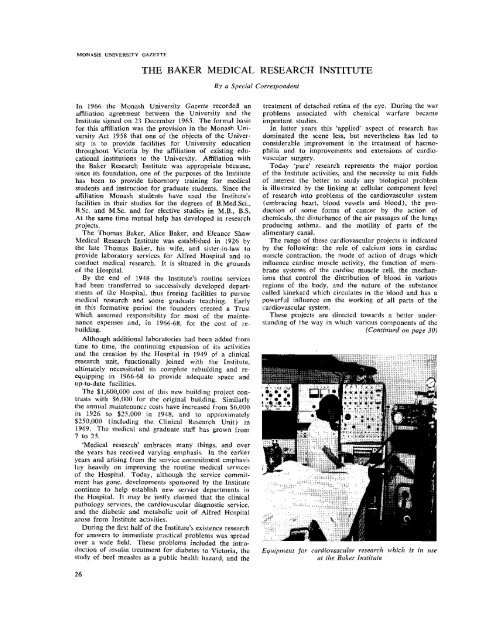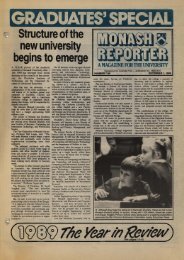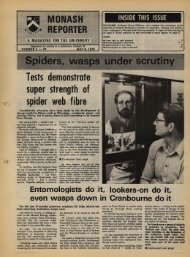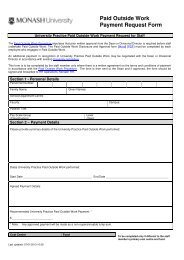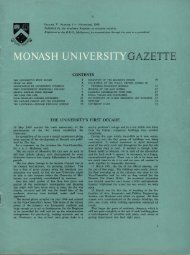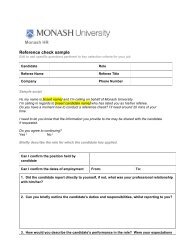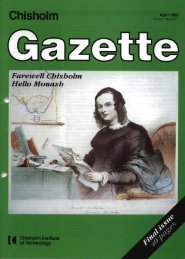MONASH UNIVERSITY GAZETTETHE BAKER MEDICAL RESEARCH INSTITUTEBy a Special CorrespondentIn 1966 the <strong>Monash</strong> <strong>University</strong> Gazette recorded anaffiliation agreement between the <strong>University</strong> and theInstitute signed on 23 December 1965. The formal basisfor this affiliation was the provision in the <strong>Monash</strong> <strong>University</strong>Act 1958 that one of the objects of the <strong>University</strong>is to provide facilities for <strong>University</strong> <strong>edu</strong>cationthroughout Victoria by the affiliation of existing <strong>edu</strong>cationalinstitutions to the <strong>University</strong>. Affiliation withthe Baker Research Institute was appropriate bec<strong>au</strong>se,since its foundation, one of the purposes of the Institutehas been to provide Laboratory training for medicalstudents and instruction for graduate students. Since theaffiliation <strong>Monash</strong> students have used the Institute'sfacilities in their studies for the degrees of H.Med.Sci.,B.Sc. and M.Sc. and for elective studies in M.B., B.S.At the same time mutual help has developed in researchprojects.The Thomas Baker, Alice Baker, and Eleanor ShawMedical Research Institute was established in 1926 bythe late Thomas Baker, his wife, and sister-in-law toprovide laboratory services for Alfred Hospital and toconduct medical research. It is situated in the groundsof the Hospital.By the end of 1948 the Institute's routine serviceshad been transferred to successively developed departmentsof the Hospital, thus freeing facilities to pursuemedical research and some graduate teaching. Earlyin this formative period the founders created a Trustwhich assumed responsibility for most of the maintenanceexpenses and, in 1966~68, for the cost of rebuilding.Although additional laboratories had been added fromtime to time, the continuing expansion of its activitiesand the creation by the Hospital in 1949 of a clinicalresearch unit, functionally joined with the Institute,ultimately necessitated its complete rebuilding and reequippingin 1966-68 to provide adequate space andup-to-date facilities.The $1,600,000 cost of this new building project contrastswith $6,000 for the original building. Similarlythe annual maintenance costs have increased from $6,000in 1926 to $25.000 in 1948, and to approximately$250,000 (including the Clinical Research Unit) in1969. The medical and graduate staff has grown from7 to 25.'Medical research' embraces many things, and overthe years has received varying emphasis. In the earlieryears and arising from the service commitment emphasislay heavily on improving the routine medical servicesof the Hospital. Today, although the service commitmenthas gone, developments sponsored by the Institutecontinue to help establish new service departments inthe Hospital. It may be justly claimed that the clinicalpathology services, the cardiovascular diagnostic service,and the diabetic and metabolic unit of Alfred Hospitalarose from Institute activities.During the first half of the Institute's existence researchfor answers to immediate practical problems was spreadover a wide field. These problems included the introductionof insulin treatment for diabetes to Victoria, thestudy of beef measles as a public health hazard, and thetreatment of detached retina of the eye. During the warproblems associated with chemical warfare becameimportant studies.In latter years this 'applied' aspect of research hasdominated the scene less, but nevertheless has led toconsiderable improvement in the treatment of haemophiliaand to improvements and extensions of cardiovascularsurgery.Today 'pure' research represents the major portionof the Institute activities, and the necessity to mix fieldsof interest the better to study any biological problemis illustrated by the linking at cellular component levelof research into problems of the cardiovascular system(embracing heart, blood vessels and blood), the productionof some forms of cancer by the action ofchemicals, the disturbance of the air passages of the lungsproducing asthma. and the motility of parts of thealimentary canal.The range of these cardiovascular projects is indicatedby the following: the role of calcium ions in cardiacmuscle contraction, the mode of action of drugs whichinfluence cardiac muscle activity, the function of membranesystems of the cardiac muscle cell, the mechanismsthat control the distribution of blood in variousregions of the body, and the nature of the substancecalled kinekard which circulates in the blood and has apowerful influence on the working of all parts of thecardiovascular system.These projects are directed towards a better understandingof the way in which various components of the(Continued on page 30)Equipment for cardiovascular research which is in U5eat the Baker Institute26
CELL BIOLOGY OF CEREALS AND OTHER GRASSESBy Dr T. P. O'Brien, Senior Lecturer, Department of BotanyThe general appearance of the organs of floweringplants (leaves, stems, roots, flowers and seeds) is familiarto all. If one cuts these organs into thin slices (lO-25~thick; Lu = 1/1000 of a millimetre) with a razor bladeand examines them with a microscope, it is easy to seethat all of these organs are composed of cells andextracellular material, the cell walls. That all organisms- plant, animal or microbe - consist of cells and theirproducts was a generality recognized clearly by the biologistsof last century. However, our modern detailedknowledge of cell structure dates only from 1949, theyear in which the electron microscope became a powerfultool in biological research. Prior to that date it hadbeen impossible to cut sections of tissues thinner than1-2"" and such sections were too thick to be penetratedby an electron beam. In 1949 it was found that, aftersuitable processing, tissues could be infiltrated withliquid perspex ('shatter-proof glass') and embedded in itby heating the liquid till it hardened. You have all seenplants and insects encased in perspex as ornaments orpaperweights. Since 1956 the epoxy resins, especiallythe commercial glue Araldite, have superseded perspex inelectron microscopy bec<strong>au</strong>se the very thin sections (0.050.1",) that can be cut from tissues embedded in hardenedAraldite are more stable than sections of perspex whenviewed in the electron microscope.Study of these thin sections (cut with glass or diamondknives on special microtomes) has yielded a rich harvestof information in the past twenty years. Detailed informationhas been obtained about the structure of thesub-cellular bodies (usually called organelles) whoseexistence had been d<strong>edu</strong>ced previously by light microscopy.In addition, other components were discoveredwhose existence had been but vaguely conceived. Carefulstudy of isolated and partially purified organelles allowedbiochemists to show that certain of the chemical reactionscarried out by intact cells were confined toparticular organelles.While the process of unravelling the functions of cellorganelles has been exciting in its own right, the resultsobtained forced biologists to recognize that the cell is <strong>au</strong>nit of both structure and function. Not only are allorgans composed of cells, but the properties of theorgans are due to the properties of their constituent cellsand cell products. Even more important has been therecognition of a second generality, namely, that similarstructures carry out similar functions no matter wherethey are found. Thus, mitochondria (one of the typesof organelle) are the major sites of oxygen utilizationin all cells that contain them, whether the cells comefrom brain or liver, leaf or stem, seaweed, fungus oramoebae. These facts have led to the development of anew field of biological inquiry, the field of cell biology.Cell biologists believe that similarities in cell structureare as important as the differences, and that informationderived about the functions of organelles in one systemmay well apply to the same organelles in quite unrelatedsystems.The great majority of flowering plants pursue a courseof growth and development with which many of usbecome acquainted as small children. Perhaps you canstill remember the fascination with which you firstwatched the daily progress of a germinating seed. Thereemerges from the seed a root and shoot which are bothsensitive to gravity, but respond by growing in oppositedirections. The root is thrust downwards (positive geotropism)while the shoot curves upwards (negativegeotropism). Provided that the shoot is in the light, itundergoes photomorphogenesis, producing leaves andstems that turn green and commence photosynthesis.The shoot commonly branches at its tip, producing newshoots which bear new leaves. The root developslateral roots, but not by tip branching, for the lateralsarise from within the parent root and at a considerabledistance from the growing root apex. The roots absorbwater and salts that are essential for the continuedgrowth of the whole plant, while the shoot manufacturesand exports sugars and vitamins to the roots and to itsown growing parts. The cycle is completed when theshoot bears flowers. These structures contain the sexorgans, the male stamens that produce the pollen, andthe female carpels (or ovaries) that produce the ovules,each with a single egg. Fertilization occurs after pollinationand the fertilized egg develops into an embryo,enclosed and shed within the seed.No family of flowering plants is more important toman than the grasses. The family (the Gramineae) includesthe cereals (wheat, rice, maize, millet, oats,barley, rye and sorghum) which are the grain crops ofthe world. Not only do these crops feed most of theworld's population, but they also provide man with hischief source of sugar from which, with the aid of yeasts,he manufactures the magic two-carbon compound,alcohol. From the animals that graze the pasture grassesof the sub-tropical and temperate regions of the world,man produces much of his diet of protein and most ofthe structural proteins (skin, wool, or their products)which clothe and protect him. However, not all of man'srelationships with the grasses are happy ones. When theygrow in places where they are unwanted, grasses areamong the most tenacious of weeds.In October 1967, the Australian Research GrantsCommittee awarded me a grant of $3,000 to initiate aprogramme of research into three aspects of grasses.This work is being carried out in collaboration with ProfessorM. 1. Canny and Mr P. F. Lumley of the Botanydepartment. In October 1968 thi .. initial grant was supplementedby a large grant of $41,000, which has enabl<strong>edu</strong>s to purchase an Hitachi HU llE electron microscope,and to add Dr S. Zee to our group as a professionalofficer. A summary of the three topics that are understudy as problems in cell biology is set out below.(i) The Germination of Wheat: Almost without exception,all seeds contain an embryo (which developsinto the adult plant) and a food reserve, both of whichare enclosed in a protective coat. Grains of cereals areno exception, for they are complex fruits, each containinga single seed. Within the seed lies a highly-developedembryo, consisting of a number of parts (Fig. 1).There is always a shoot apex surrounded by a numberof immature leaves that it has produced; the apex andleaves are enclosed in a special organ found only ingrasses, the coleoptile. This hollow, cylindrical sheathis sensitive to light and gravity and after germination it27


